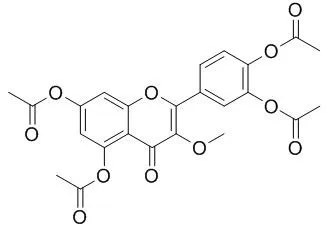| In vivo: |
| Planta Med.,2007,73(11):1156-62. | | Potent suppressive effects of 3-O-methylquercetin 5,7,3',4'-O-tetraacetate on ovalbumin-induced airway hyperresponsiveness.[Pubmed: 17823872 ] | We investigated the suppressive effects of 3-O-methylquercetin 5,7,3',4'- O-tetraacetate (QMTA), a more-potent phosphodiesterase (PDE)3/4 inhibitor than quercetin 3-O-methyl ether (3-MQ), which has been reported to have the potential for treating asthma, against ovalbumin (OVA)-induced airway hyperresponsiveness (AHR). The IC50 value of QMTA for PDE3 was significantly less than that for PDE4.
METHODS AND RESULTS:
According to the Lineweaver-Burk analysis, QMTA (1-10 microM) competitively inhibited PDE3 and PDE4 activities. The Ki values were 0.9+/-0.3 (n=5) and 3.9+/-0.5 (n=5) microM, respectively, which significantly differed from each other, suggesting that QMTA has higher affinity for PDE3 than for PDE4. QMTA (3-10 microM) concentration-dependently relaxed the baseline level, and significantly inhibited cumulative OVA (10-100 microg/mL)-induced contractions in isolated sensitized guinea pig trachealis suggesting that QMTA has bronchodilator and inhibiting effects on mast cell degranulation. After the secondary challenge, the AHR was measured in unrestrained OVA-sensitized mice, with nebulized methacholine (MCh, 6.25-50 mg/mL), by barometric plethysmography using a whole-body plethysmograph. In the present results, QMTA (3-10 micromol/kg, I. P.) dose-dependently attenuated the enhanced pause (Penh) value induced by MCh (25-50 mg/mL). QMTA (3-10 micromol/kg, I. P.) also significantly inhibited total inflammatory cells, macrophages, neutrophils, lymphocytes, and eosinophils in BALF after determination of Penh values. It also significantly suppressed the release of interleukin (IL)-2, IL-4, IL-5, IFN-gamma, and TNF-alpha, with the exception that 3 micromol/kg QMTA did not suppress the releases of IL-5. QMTA even at 1 micromol/kg significantly inhibited eosinophils, IL-2, and TNF-alpha.
CONCLUSIONS:
In conclusion, our results strongly suggest that QMTA has greater potential than 3-MQ for the treatment of asthma. |
|






 Cell. 2018 Jan 11;172(1-2):249-261.e12. doi: 10.1016/j.cell.2017.12.019.IF=36.216(2019)
Cell. 2018 Jan 11;172(1-2):249-261.e12. doi: 10.1016/j.cell.2017.12.019.IF=36.216(2019) Cell Metab. 2020 Mar 3;31(3):534-548.e5. doi: 10.1016/j.cmet.2020.01.002.IF=22.415(2019)
Cell Metab. 2020 Mar 3;31(3):534-548.e5. doi: 10.1016/j.cmet.2020.01.002.IF=22.415(2019) Mol Cell. 2017 Nov 16;68(4):673-685.e6. doi: 10.1016/j.molcel.2017.10.022.IF=14.548(2019)
Mol Cell. 2017 Nov 16;68(4):673-685.e6. doi: 10.1016/j.molcel.2017.10.022.IF=14.548(2019)